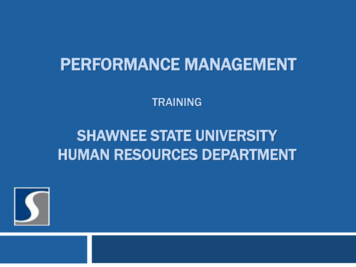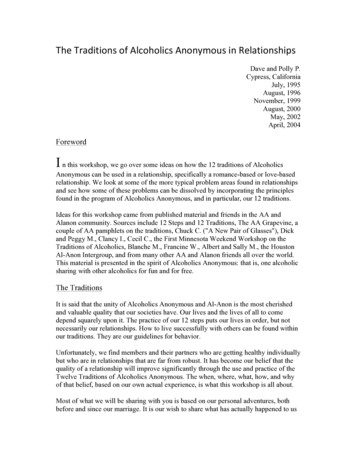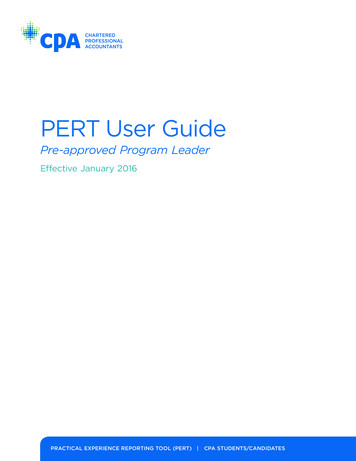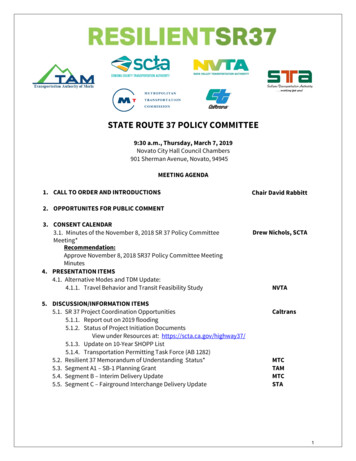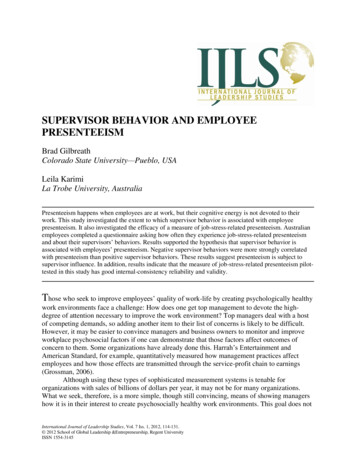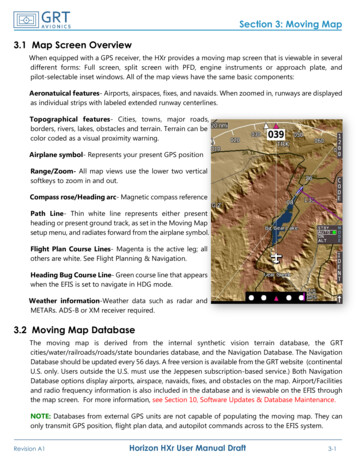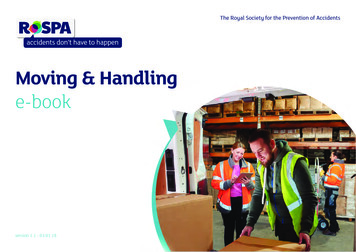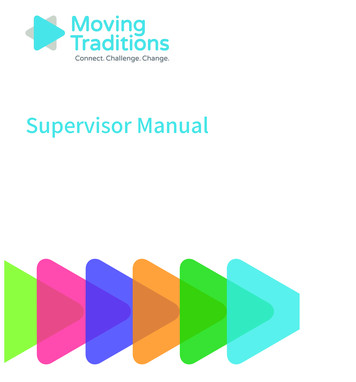
Transcription
Supervisor Manual
Table of ContentsPreface . 1Why Moving Traditions? . 2Being a Supervisor . 3Starting and Nurturing a Group . 4Finding and Hiring the Right Group Leader . 16Recruitment and Communication with Parents and Participants . 23Appendix A: Making the Most of This Material (Rosh Hodesh) . 30Appendix B: Making the Most of This Material (Shevet). 47Appendix C: A Few Notes on Running Successful Groups . 61Appendix D: Branding Guidelines for Moving Traditions’ Partners . 68Appendix E: A “Taste of” Rosh Hodesh: Parent/Teen Session . 73Appendix F: A “Taste of” Shevet: Parent/Teen Session . 95
PrefaceThank you for joining in partnership with Moving Traditions to answer the question:How can we draw on Jewish values and a gender lens to help pre-teens and teensaddress the joys and challenges of their daily lives – so that they flourish?Teens need us—given academic stress, bullying and friendship conflict, confusion aroundromantic and sexual relationships, and other challenges of adolescence, magnified by socialmedia. However, most teens drop out of Jewish activities after b’nai mitzvah, just when theycould most benefit from our guidance.We know from our research that teens love Rosh Hodesh and Shevet, where they gather insame-gender and same-grade groups led by Moving Traditions-trained adult leaders. Teensgreatly appreciate being given Jewish and secular tools to explore the social and emotionalissues that are so central to their lives, where they can challenge gender norms in a safe peergroup. Through this transformative experience, teens are empowered to find meaning andconnection in Jewish community.As you launch Moving Traditions groups for teens in your community, I welcome yourpartnership in helping Jewish teens to: Experience Jewish community as a source of support and strength.Challenge narrow and negative ideas of what it means to be a woman or man, or human, putforward by our society.Believe that women and men and people of all genders are full and equal participants in Judaismand in every sphere of life.Expect to participate in a Rosh Hodesh or Shevet group, as they expect to become a b’nai mitzvah.Become leaders in both secular and Jewish life.I wish for you and the teens in your community a deeply meaningful experience in your RoshHodesh and Shevet groups. Thank you for working with Moving Traditions, so that more teenswill thrive—confident, compassionate, and connected to Jewish life.Deborah MeyerMoving TraditionsFounder and Chief Executive Officer Deborah Meyer has years of experience in the non-profit world, buildingfeminist and Jewish organizations and working for social change.movingtraditions.org1
Why Moving Traditions?The need: Today’s pre-teens and teens are confronted with greater academic and social pressure at anearlier age and a faster pace than ever before. Framing their lives is #metoo, online pornography,cyberbullying, mass shootings, and growing anti-Semitism. They spend more time on screens thanwith friends in person, giving rise to growing anxiety, depression, and loneliness. At the same time, thisis a generation of creativity, social consciousness, and pride in being Jewish.The opportunity: Research shows that we can help pre-teens and teens thrive and experience Jewishcommunity as personally meaningful when we meet them where they are—at the most relevant times andin the most relevant ways—empowering them to address the challenges and the joys of their daily lives.Our unique model: Moving Traditions has pioneered a whole teen approach to Jewish education thatdraws on ancient Jewish wisdom and the latest in adolescent psycho-social development to foster selfdiscovery, challenge sexism, and inspire commitment to Jewish life and learning. We have beenselected for 11 years for the Slingshot guide to Jewish innovation.The organization creates immersive group experiences exploring the issues that matter most to preteens and teens—such as self-esteem, friendship, academic pressure, party culture, social anxiety, andsexuality—under the guidance of adult mentors we train to foster an environment of safety, substance,fun, friendship, and growth. Groups meet for two hours, once a month, with a Moving Traditions’trained group leader.Moving Traditions’ Pathway of new and expanded programs: We’re starting earlier, with new b’naimitzvah family education and pre-teen sessions in 6th and 7th grade—at the critical transition frompre-teen to teen, when families are most active in Jewish life—creating a pathway to our groups forteens in 8th grade through high school, Rosh Hodesh for girls, Shevet for boys, and now also Tzelem fortrans and nonbinary teens, which have inspired more than 21,000 teens and 1,600 adults trained byMoving Traditions as mentors to find meaning and connection in Jewish life.B’nai mitzvah podcast: In fall 2018 we launched @13, a 6-episode podcast for parents who want tothink differently about b’nai mitzvah and the sometimes confusing, often emotional, and ultimatelytriumphant process. In the podcast, rabbis, comedians, psychologists, parents, and teens discuss theancient roots and modern realities of this Jewish rite of passage.New summer camp program: In response to #metoo, Moving Traditions is drawing on the Jewishsexuality curriculum created for our teen groups, working with a range of Jewish summer camps acrossthe country, training leaders to train their counselors to create safety and respect for all staff andcampers. Summer camp deeply impacts Jewish identity and serves as a training ground for Jewishleaders but can also reinforce destructive cultural norms.2movingtraditions.org
Being a SupervisorSupervisors of Moving Traditions teen groups (Rosh Hodesh, Shevet and Tzelem) areultimately responsible for the recruitment, launch and support of Moving Traditions teengroups. This encompasses the following:1. The selection and vetting of potential group leaders, ensuring that group leaders aretrained by Moving Traditions within the past five years. (See “Finding and Hiring the RightGroup Leader” for more information on selection of group leaders.)2. Publicizing the programs and overseeing communication with parents prior to grouplaunch and throughout the year.3. Support of group leaders:a. Ensure that a yearly schedule of all group sessions is established and communicated toparents at the beginning of each program year.b. Set regular or semi-regular meetings with your group leaders to support planning forand debrief of each session.c. Be attentive to the unique needs of group leaders as they support the social andemotional needs of teens.d. Enable group leader professional enrichment by support of participation in MovingTraditions’ advanced trainings, pilots, webinars, and other learning opportunities.4. Provide parent and participant information to Moving Traditions.5. Support group continuity from year to year.movingtraditions.org3
Starting and Nurturing a GroupThank you for nurturing Moving Traditions’ teen groups in your community. We are pleasedthat you have joined the hundreds of Jewish clergy and educators across North America whoserve as supervisors and guides to the group leaders and teens in their Rosh Hodesh, Shevet,and Tzelem groups.Your role as a supervisor is paramount to the success of the teens’ experience in your MovingTraditions’ programs, as well as the experience of your group leaders. Supporting your groupleaders as they bring their different skills and strengths to the group will only enhance thegroup and help your teens reach our shared outcomes.Regardless of your background, one of the most important things you will bring to thisexperience is your kavannah—your intention. Adolescents are experts in detecting who isbeing “real,” so enjoy the experience and be authentic with them as you engage them in thesegroups.Steps for the Supervisor and Group LeaderThis task list is explained in detail in the paragraphs that follow:1.2.3.4.5.Identify the age group(s) with which you will be working.Identify potential meeting times and locations.Publicize the program and recruit members.Invite teens and parents to an Introductory Meeting (“Taste of Rosh Hodesh/Shevet”).With your group leader(s), establish and sustain relationships with parents and teensbefore the group begins and between meetings.6. Have your group leader(s) apply to and attend a Moving Traditions’ national trainingconference; attend the training yourself and make the most of ongoing support.7. Partner with Moving Traditions for the continued success of your Rosh Hodesh andShevet groups.1. Identify an age group.Both programs are designed for teens to begin in 8th grade. In the 8th grade year, teens havealready experienced their b’nai mitzvah and have reached a new level of maturity. Tap into anexisting group of post-b’nai mitzvah teens or identify the potential group while they are still in7th grade. Research shows a dip in participation in Jewish life at this stage. Rosh Hodesh andShevet can keep teens engaged and connected with your institution and with each otherthrough a meaningful and engaging post-b’nai mitzvah Jewish experience.4movingtraditions.org
2. Select meeting location and times.The space in which the teens gather should be informal and intimate yet provide amplespace for approximately eight-ten teens to sit in a circle. It must offer privacy and be a placewhere food and various activities will be welcome. Everything does not have to take place inthe same room. You may gather initially in one setting, and adjourn to another space forgames, crafts, eating, or other activities. It’s a good idea to check the sessions in advance forany special monthly requirements (e.g., space for physical activity). There are two models thathave been successful: home-based and institution-based.Home-based GroupsHome-based groups, which rotate the meetings among the teens’ homes, provide inviting,hospitable environments. They foster the teens’ sense of ownership of the group andcommitment to its success. Host teens can be asked to assume a variety of leadership roles,from phone calls to facilitation. Meeting in homes may require attention to socioeconomicdifferences among the teens and may present challenges related to family lifestyles, such asnoise, parent or sibling intrusion, comfort with “mess,” level of kashrut, or allergies to pets. Ifyou are holding the first gathering in a home, you may not be able to confirm the location untilthree to five weeks in advance, when you have a few teens on board and have received acommitment from a host parent.Institution-based GroupsAlternatively, your sponsoring institution may prefer to host the monthly gatherings in its ownfacility. This model can provide consistency for the group and deepen the teens’ relationshipwith the host institution. If you are meeting in an institutional setting, you may wish to payextra attention to ritual and decorative features that will increase the sense of intimacy andownership of the space. Teens can rotate being the “designated Host Teen,” providing food,helping to set up the room, and possibly facilitating part of the meeting.SchedulingYour choice of meeting time may intersect with your choice of location. For instance,institutions’ buildings may be open on a limited schedule. Many groups meet one Sundayafternoon or evening a month, while others find a weekday afternoon or evening moreamenable. Make sure that the time and place you pick is optimal for most of the teens who willbe in your group and be consistent with day and time—unless you need to adjust the scheduleto avoid secular and religious holidays and competing events in the community.3. Promote the program and recruit members.Your objective should be to create wide name recognition for the program, create a “buzz” inthe community, and stimulate interested teens and parents to find out more—or at least to bemovingtraditions.org5
receptive when your individualized letter arrives. Plan a multi-pronged approach to lettingteens and their parents know about the program.You can recruit teens using these strategies: Encourage word-of-mouth and peer outreach by teens participating in an existing group.Speak with parents in adult Jewish groups.Mail flyers using institutional mailing lists.Send announcements using institutional e-mail lists.Place articles in institutional/organizational newsletters.Place listings and/or advertisements in organizational program guides.Post announcements on web sites.In addition, community institutions may also offer you the opportunity to publicize through: Placing brochures and posters in community settings (JCCs, pizza shops, cafes, etc.).Staffing a table at special events, such as community fairs.Our Recruitment Toolkit is available on the Moving Traditions website (see also Appendices Eand F). It includes sample letters to parents as well as curricular materials to run a “Taste ofRosh Hodesh/Shevet” session for parents and teens. Most importantly, talk it up to as manypeople as you can. Spread the word!Emphasize Peer and Parent OutreachNote that one effective, time-efficient way to get a group going is to find an interested teen orcore of teens who will want to involve their friends. As you would expect, teens are more aptto attend if they know that their friends will be there. If there is an existing group in your area,asking current participants to do peer outreach can be very effective. Parents can also begreat assets to recruitment. Find one or two parents who have age-appropriate teens to helpyou build the group.4. Invite teens and parents to an introductory meeting.We have found that an introductory meeting with teens and parents is one of the mosteffective ways of obtaining a commitment from both the teens and their parents. This session,“Taste of Rosh Hodesh/Shevet” provides information about the program and allows both toexperience firsthand what a session is like. It is best to host this meeting in the spring—before the teens go away for the summer. Excite the teens and parents early and you won’thave to run after them later!6movingtraditions.org
Typically, the group leader who will be facilitating the group offers the session with yoursupport. You can also invite an experienced group leader to help facilitate. If possible, invite ateen or some teens who have participated in a previous or ongoing group to attend and“excite” the teens about the program.Rather than sending emails, you may want to personalize invitations to the introductorymeeting, hand-address the envelopes, and mail with eye-catching stamps. You can also use anonline invitation app. Depending on your role at your organization and your comfort level withthe teens/their families, you might also consider calling each teen whom you have invited andextending a personal invitation. These personal touches may seem insignificant and timeconsuming, but they will signal to each teen that they are being personally invited to a specialgroup.Our experience supports publicizing the group to large numbers and inviting about 20teens to the introductory teen-parent meeting. This usually becomes a group of 8-12committed and excited teens for your ongoing group. It generally takes a few sessions for thegroup to “settle in” and a core group of steady teens to solidify. The group may choose tobecome closed at that point or explore the inclusion of new members as the issue arises.Follow-upWe strongly recommend that soon after a teen has expressed interest in a group, you have aconversation with their parent(s). In addition to reviewing the expectations regarding meetingtimes, attendance, hosting, and costs, this will give you the opportunity to answer parentalquestions and address any concerns. It will also allow you to ask the all-important question,“Is there anything I should know about your child?” so that you can be made aware ofconcerns, such as kashrut, allergies, disabilities, and any other religious, health, or socialissues.5. Establish and sustain relationships with parents and teens before the group begins andbetween meetings.ParentsParent understanding of and support for your group is vital to the group’s success. Beyond thepracticalities of driving the teens, paying for the group, hosting meetings, and puttingmeetings on the family calendar, parents can support the mission and vision of MovingTraditions in important ways. When parents understand the group, they “spread the word” inthe community for future groups, support institutional funding, reinforce concepts at home,and can be resources for you, as well.In coordination with your group leaders, parents need to be informed about the nature andintent of the monthly gatherings and the expectations for their involvement. If your groupmovingtraditions.org7
meets in homes, it is particularly important that parents fully understand the group’s needsfor privacy and appropriate spaces for food, and other activities. Follow-up communication toconfirm dates and location of meetings is also important. E-mail parents monthly with asummary of the last session, without sharing any information that violates the group’s “safespace.” By focusing on the objectives listed at the beginning of each curriculum session, andmentioning a couple of discussion questions you asked, you can inform parents about thesession while respecting the group’s commitment to confidentiality. You might also choose toshare a relevant news article about or teens with parents in the emails you send. MovingTraditions frequently posts timely articles on the Trained Group Leader Facebook page fromwhich you can draw. By sharing articles, you can engage parents in the issues related to teens,gender, and Judaism explored within the group.Other ideas for connecting with parents include hosting a parent/child session, a parent/childend of year celebration, or parent workshop.Top Ideas for Connecting with Parents1. Host a Taste of meeting as a part of your recruitment strategy. Even if you aren’t recruitingteens, it’s a great opportunity to connect with families in your group.2. Email parents regularly with a summary of your session based on the objectives. Parentslove to be kept in the loop about what the teens explored in their gathering- but remembernot to reveal anything private or violate the safe space of your group.3. Whenever possible, ask families to host sessions at their homes—both teens and parentsvalue the opportunity to bring the group experience into their homes. Plan to touch basewith host families a few weeks before the gathering to confirm details.4. Work with your group leader to establish a lay committee of parents to support RoshHodesh and Shevet at your institution. The committee can plan social and educationalevents for parents and sow the seeds for future groups.5. Some parents have expressed interest in holding their own adult version of RoshHodesh/Shevet groups. Though Moving Traditions bears no direct connection to thesegroups, we are delighted to know that parents are meeting and organizing.TeensThe teens will grow to appreciate that this is a group of their own. (For many of them, this willbe the first Jewish educational experience that they are choosing for themselves.) From thestart, it is important that the group leader conveys to them that they are partners inestablishing a unique, special, and valuable experience. If possible throughout the year,encourage your group leaders to find opportunities to briefly connect with each teen one-onone. The most natural time to do this might be with a host teen either right before or rightafter a meeting. Ask them about their interests. Listen to the teens and learn about them rightfrom the onset of your relationship.8movingtraditions.org
This program is a unique model, different from their other experiences—the group leadershould let teens sense this from the start. The medium is the message. Make sure all of yourmaterials are colorful, teen-friendly and reflect the fun experience they will have in theirgroup. Hold high expectations for the teens’ involvement in the group and, of course, foryourself. Let the teens know you and your institution value their experiences by bringingthoughtfully prepared, high-quality supplies. Provide snacks (or encourage host families toprovide snacks) that are both healthful and fun. Most of all: let the teens be themselves.It may take several meetings for the group to bond and for friendships to form. Group leaderscan help this process by cultivating the group between meetings. Group leaders have sentbirthday cards, pictures of the previous meeting, articles of interest, and appropriate web sitelinks to the teens. Be patient—we expect that over time your high expectations for the groupwill be fulfilled and all your nurturing efforts will bear fruit.6. Have your group leader(s) apply to and attend a Moving Traditions’ national trainingconference; attend the training yourself and make the most of ongoing support.Attendance at a Moving Traditions National Training Conference is required for all new groupleaders and recommended for supervisors. Our conferences are consistently rated byparticipants as a “superior professional development” opportunity. Our professional trainersare knowledgeable and passionate about Moving Traditions, are excited to meet you, and arecommitted to working with you to ensure that your program experiences will be wonderful—for you, your institution, and most importantly, the teens. You will meet other supervisors andfacilitators from around the country and will gain proficiency in: Using the program materials.Facilitating groups and supervising group leaders.Understanding gender issues in adolescence.Supporting your educational staff in facilitating experiential Jewish learning and ritualMarketing and recruitment.Moving Traditions is committed to your success. We encourage you to take advantage ofthe consultation and support we offer through our website, our Facebook page, e-mail, andpersonal contact with our national and field support staff.7. Partner with Moving Traditions for continued successOur programs are the product of many years of writing, field-testing, and editing—madepossible by Moving Traditions’ staff and Board and by the national funders committed to theprogram and its mission. It is also a living, dynamic program that is being expanded andupdated every year. Please let us know if you run into any difficulties so that we can help youresolve them.movingtraditions.org9
You are a crucial link in the chain of this program’s continuity. Every time you report awonderful experience, give us feedback that will allow us to improve the curriculum, or postan idea in our Facebook group, you are contributing to the program and helping to supportyour colleagues and teens across the continent. Send us pictures of your group activities andshare both your challenges and successes! Encourage your group leaders to share theircomments in the comment box on our website below each session plan.Finally, you and your group leaders are Moving Traditions’ links to the teens and their families.Moving Traditions requires all institutions that are using our materials to send us contactinformation for all program participants and their parents. This includes each participant’s fullname, mailing address, email address, synagogue, and grade, as well as their parents’ names,mobile phone numbers, and email addresses. We need this important information to shareresources with parents, and to conduct evaluations of the programs—and we thank you inadvance for your assistance!10movingtraditions.org
Successful Timeline for Starting and Nurturing Your GroupNote: This three-month timeline/checklist is structured to lead to a teen-parent introductorymeeting prior to the launching of your group. You may need to adapt it to your own needs, butwe suggest that you refer to it regarding sequencing and timing of tasks.The Spring Before Launching a Group (April-June)Decide who, where, and when: Identify age/grade level for outreach.Identify group leader (see more below).Get contact information for each teen and their parents in order to invite them.Set the date, time, and place for the teen-parent introductory meeting and spread theword: Reach out to your Moving Traditions regional staff person for guidance. Use the template flyer for a Taste meeting on our website (under Recruitment Toolkit.) Publicize: send e-mails, go into Hebrew School classrooms, distribute flyers to parents,send snail mail, make calls—get teens and their parents to this meeting! Invite theteens to bring a friend. Send invitation letters to prospective parents and, a few days later, to their child. (Seesample letters on the following pages.) Prepare for the meeting. (See the Taste of Appendices at the end of this manual.)Host the teen-parent introductory meeting: Collect contact information of teens and parents that attended. Ascertain best times and locations for group meetings. Get the teens and their parents excited before they go away for the summer and, ifpossible, let them know the date of their first group meeting in the fall.Identify potential times and places for monthly meetings.Finalize time and place for monthly meetings in conjunction with your group leader.If needed, determine best ways to recruit more teens by the fall (i.e., teens bring friends, etc.)The Late Spring and Summer (June-August)Get people on board to support the group’s success: Expand name recognition and reinforce a strong “buzz” in your institution. (Print an articleabout the group in the institutional bulletin, Hebrew School launch packet, etc. ) Speak with parents in adult Jewish groups rabbis, other educational staff, board members. Themore people who are invested in the success of the program, the more successful it will be. Develop the meeting schedule for the year, consulting the holiday schedule, community,and institution calendars. Distribute the schedule both with the letters to the parents andat the teens’ opening gathering.movingtraditions.org11
Work with your group leader to write a letter of invitation and introduction to the parentsof teens who have expressed an interest in joining the group. Include: A reminder of the introductory session last spring. Where and when the group will be meeting. Any fees. Your enthusiasm for the new group.Create a fun, personalized note or postcard to each teen, inviting them to the first meeting,to go out at the end of the summer (one group leader even took the time to send sillyplastic eyeballs to potential participants to invite them to “see” things differently).Communicate your plans with your Moving Traditions regional staff.The Late Summer/Early Fall (Just Before the Group Begins)Confirm attendance for the first meeting: Send the invitation to each teen. Work with your group leader to call each household to find out whether they received theinvitation and to personally confirm attendance at the first meeting. Try to speak with boththe parent and the child. Answer any questions. Review the few expectations the group will place on parents, including hostingparameters (privacy, space for activities, contribution of food and snacks), fees, etc. Confirm first gathering date(s) and location(s). Ask whether there is anything helpful for you to know about the needs of the child (e.g.,kashrut, allergies, other special health needs or issues). Ensure an email or letter is sent to host parents to confirm expectations. Send reminder e-mail to full list, confirming time and place of first gathering. Check in with your Moving Traditions regional staff person for guidance as you prepare forthis meeting.Year Two and Beyond: Preparing for the Following YearIn the spring:Planning (and securing funding) for the next year of your programs should begin in the springof your current year! The intention is for groups to continue together for multiple years, as itoffers the teens ongoing opportunities to grow, learn and gather with friends. Ask the participants and parents if they plan to continue Ask the group leader if they plan to continue. If not, hire someone new and plan for themto attend training. Decide whether there is a need to invite new participants to join the group. Meet with the group leader (new and/or continuing) and review any feedback you havereceived from the participants at the final meeting.12movingtraditions.org
Set the date and host for first meeting of new year in the Fall.Communicate your plans to Moving Traditions, so that we can support you as you continueyour group.In the summer1. Review any feedback received from the teens at the closing session. Consider withyour group leader how you will incorporate this information for the coming year.2. Preview the sessions for the coming year and decide what special events might beincorporated for the coming year, such as a parent-child session, field trips, orpresentations.3
6. Have your group leader(s) apply to and attend a Moving Traditions national training conference; attend the training yourself and make the most of ongoing support. 7. Partner with Moving Traditions for the continued success of your Rosh Hodesh and Shevet groups. 1. Identify an age group. Both programs are designed for teens to begin in 8th .
